FORCE UNIT
TERMS TO BE REMEMBERED:-
- What is a force: Force is defined as an external cause which changes or tends to change the state of rest or uniform motion of a body in a straight line in force unit.
- Type of force: Contact force ( force of pull or push, the frictional force between two surfaces, force of tension) AND Non-contact force ( gravitational force, magnetic force, electric force).
- Gravitational force: It is a force of attraction between any two bodies when one body is very large in mass as compared to the other body.
- Moment of force or Torque = Force X Perpendicular distance of the force
= FXr
- Torque is a vector quantity: If the turning effect or direction of rotation of the body is anti-clockwise then it is considered as positive torque. If the turning effect or direction of rotation of the body is clockwise then it is considered as negative torque.
- SI unit of Torque : newton X metre ( NM)
- MKS unit of Torque : kilogram-force X metre (Kgfm)
- CGS unit of torque : dyne X cm
- Relation between SI unit and CGS unit : 1 Nm = 105dyne X 100 cm = 107 dyne cm.
- Principles of moments: In rotational equilibrium algebraic sum of all moments acting on a rigid body is When a number of forces in the same plane at different points on a rigid body, the body may rotate clockwise or anti-clockwise depending upon its rotation. However, if the body is still stationary it means the net effect of all moment is zero. (FORCE IN PHYSICS)
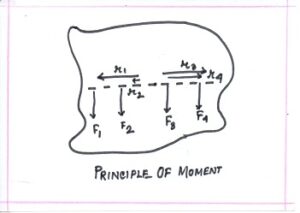
PRINCIPLE OF MOMENT
According to the Principles of the moment if the body is not moving, then the algebraic sum of all four moments is zero.
So, F1 X r1 + F2 X r2 – F3X r3 – F4 X r4= 0
Or, F1r1+ F2r2 = F3r3+ F4r4
- Verification of the principle of the moment: Let the weights W1 and W2 are suspended on the left side of the rule of thread at distances of l1and l2 These weights will try to turn the rule anti-clockwise. Hence the sum of all anti-clockwise moments = W1 X l1+ W2l2.
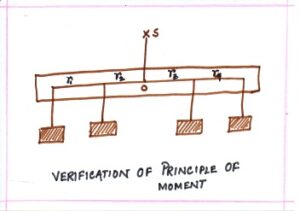
VERIFICATION OF PRINCIPLE OF MOMENT
In the same way the weights W3 and W4 are suspended on the right side of the thread at the distance l3and l4 respectively. These weights will be allowed to turn the rule or scale towards clockwise. That is why, sum of all clockwise moments = W3X l3 + W4X l4.
In equilibrium , when rule is horizontal sum of all anti- clockwise moments = sum of all clockwise moments = W1 l1 + W2 l2 = W3 l3 + W4 l4
This verifies the principle of moment.
- Couple:- When two similar and opposite forces which are parallel act at a similar distance on each side of the point of rotation of the body, the sum of their moments forms a torque. A body is allowed to be free to rotate about O. two forces each of magnitude F act at points A and B such that distances will be OA = OB.
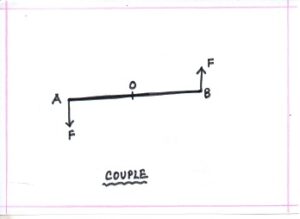
COUPLE
Moment of force at A = F X OA ( in an anti-clockwise direction)
Moment of force at B = F X OB (in a clockwise direction)
Sum of clockwise and anti- clockwise moments or couple = F X OA + F X OB = F (OA +AB) =
F X AB.
Centre of gravity of regular shaped bodies:
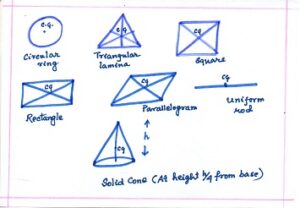
PROBLEMS RELATED TO FORCE
Very short type qs:-
1)Which device is used for measuring mass and weight. (FORCE IN PHYSICS)
Ans) Physical balance to measure mass and Spring balance to measure weight.
2) The position in the centre of gravity of a body depends upon which factors?
Ans) Centre of gravity of a body depends on where more weight is present in the body.
3)What are the factors which affect the turning effect of a body.
Ans) The factors affecting the turning effect of a body are:- a) force; b) distance between the point of rotation and point of action of the force.
4) which is the condition when the momentum change of a body depends only on the velocity change?
Ans) When the mass of the body remains constant.
5) For a particle in a uniform circular motion, what is the direction of its velocity at any point in its path?
Ans) Along the tangent to the circle at the point.
6) How is force related to the momentum?
Ans) F = ΔP /Δt
7)For a particle in uniform circular motion, what is the direction of its velocity at any point in its path?
Ans) Along the tangent to the circle at that point.
8) Speed or velocity or both, which remains constant during uniform circular motion?
Ans) Speed remains constant in a uniform circular motion then it is called dynamic equilibrium.
9) State the momentum formula. (FORCE IN PHYSICS)
Ans) Product of mass and velocity ( p = m X v).
10) What is the unit of force?
Ans) Kilogram metre per square second ( kg ms-2)
Short type qs:-
1) In which condition, the following are produced by a force?a) translational motion
b) rotational motion
Ans) The conditions are as follows:
i)when the body is free to move in a straight path for “Translational motion”.
ii)when the body is pivoted at a point for “Rotational motion”.
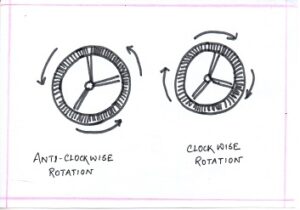
2) What do you mean by the terms
i) static equilibrium
ii) dynamic equilibrium
Ans) i)If a body has a tendency to return its original position, after being slightly disturbed from its equilibrium position then it is called static equilibrium.
ii) If a body has no tendency to come to its original position after being disturbed from its equilibrium position then it is called dynamic equilibrium.
3) Where does the position of the centre of gravity lie for i) circular lamina; ii) triangular lamina. (FORCE IN PHYSICS)
Ans) i) For a circular lamina the position of the centre of gravity lie at the centre of the circle.
ii) For a triangular lamina the position of the centre of gravity lie at the centroid or the point of intersection of the median.
4) A force is applied on i)a rigid body; ii) a non-rigid body. How does the effect of the force differ in the above case?
| FORCE APPLIED ON RIGID BODY | FORCE APPLIED ON A NON-RIGID BODY |
| i)The force does not change the inter-spacing between its constituent particles. | i)The force changes the inter-spacing between the constituent particles. |
| ii)It does not change the dimension of the oject. | ii) It changes the dimension of the object. |
| iii)It causes motion in it. | iii)It does not cause motion in it. |
5) Read each statement carefully and state with reason, if it is TRUE or FALSE.
i) For a body moving in a circular path with a constant speed, the acceleration is centripetal in nature.
Ans) TRUE; the direction of acceleration is perpendicular to the direction of motion at every point. It acts along the radius of the circle and directed towards the centre.
ii) The total acceleration of a particle with circular motion is always through the radius of the circle towards the centre.
Ans) FALSE: because the net acceleration is directed towards the centre only in case of uniform circular motion.
6) What is the nature of centripetal force on the planet?
Ans) The centripetal force on the planet is gravitational which is attractive in nature.
7) State the law of universal gravitation and example.
Ans) Let m be the mass of a body on the planet which falls towards it with acceleration g; M is the mass of the planet and d is the distance between the centre of the body and centre of the planet; so F be the gravitational force : F = mg = GMm/d2 OR g = GM/d2; assuming d is a constant so g ∞ M.
Explanatory question:-
- A stone tied at the end of the string is whirled in a circle. If the string breaks, then the stone flies away tangentially. WHY?
Ans ) When a stone is moving around a circular path, then the instant velocity of stone is along the tangent path to the circle.
- How the motion of a planet around the sun in a circular path can be explained?
Ans) A planet moves around the sun in a circular path for which the force of attraction on planet by the sun provides the necessary centripetal force.
- Explain the fictitious force and also explain how does it play an important role in a circular motion.
Ans) A force which is not real is called fictitious force. Centrifugal force is a fictitious force. It is the apparent force that draws a rotating body away from the centre of rotation.
- Why does a rope walker hold a long pole in his hands?
Ans) The rope walker holds a long pole in his hands to adjust the centre of gravity. When he feels that he is falling towards right he shifts the pole towards left so that his centre of gravity is not disturbed and he can balance.
- The passengers in a boat are not allowed to stand while crossing a river. WHY?
Ans) This is because, if the passengers stand, then the centre of gravity of the boat is raised . this may cause the boat to overturn as well as producing imbalance.
- The screwdrivers have long-handled, WHY?
Ans) According to the formula torque = force X perpendicular
So, distance = F X D
If the handle is long, the value d is more, hence more torque is produced.
- Write the differences between centripetal and centrifugal force.
Ans)

| KEY POINT | CENTRIPETAL FORCE | CENTRIFUGAL FORCE |
| Definition | A force which acts o a object towards the centre of a circle to produce centripetal accelerations, so that the object moves in a circle is known as centripetal force. | A force which does not act on the object moving in the circle but it is equal and opposite to the centripetal force called centrifugal force. |
| TYPE | It is a real force | It is a fictitious force. |
- You always keep your feet wide apart when receiving the charge from an opponent at football.WHY? ( Force in physics)
Ans) While receiving the charge from an opponent at football, we keep our foot wide apart to adjust the centre of gravity as low as possible to maintain ourselves to a stable equilibrium. Thus, on hitting we do not fall. Similarly, players do the same while playing.
D) Work formula maths:
1) A uniform metal rod of 5m in length and weight 90w is suspended horizontally by two vertical wires attached at 50 cm and 3.5 cm respectively, from one end of the rod, find the tension in each wire.
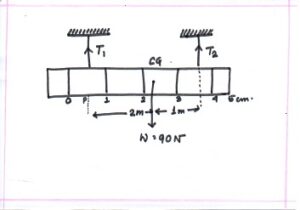
Ans) It is an example of spring force.
Let tension in the wire be T1 and T2. As the rod is uniform its weight acts as centre of gravity of the rod i.e at 2.5 cm from one end.
According to the principle of moment, sum of upward force = sum of downward force ; so, T1 + T2 = 90N. clockwise moment = anticlockwise moment ; T1X 2 = T2X1 OR T1/T2= ½ ;
1X + 2X = 90
OR, 3X = 90
OR, X = 90/3 = 30; so, T1= 30N and T2 = 60N.
2) A half metre rod is pivoted at the centre with two weights of 20gf and 12gf suspended at a unperpendicular distance of 6 cm and 10 cm from the pivot respectively as shown in the figure: i) which of the two forces acting on the rigid rod causes clockwise moment?
Ans) Force due to 12gf the rigid rod causes clockwise movement.
ii) Is the rod in equilibrium?
Ans) To know the equilibrium state of rod, we have to know it’s clockwise and anticlockwise movement:
Clockwise movement = 12gf X 10 cm = 120 gf cm.
Anticlockwise movement = 20gf X 6 cm = 120 gf cm.
Therefore, clockwise movement = anticlockwise movement. So the rod is in equilibrium.